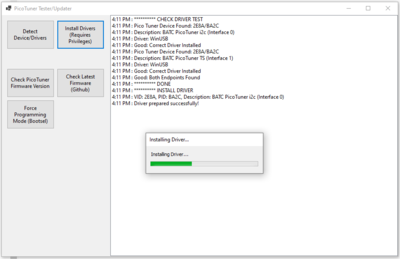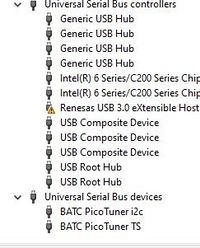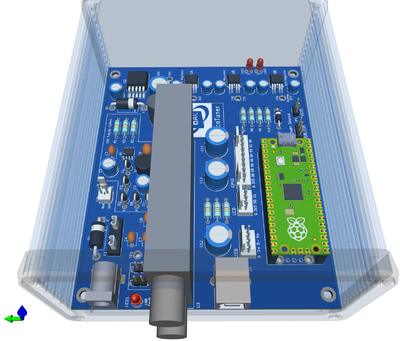Difference between revisions of "PicoTuner"
| (19 intermediate revisions by 3 users not shown) | |||
| Line 3: | Line 3: | ||
The main reason for the development is to use the £5 Raspberry Pi Pico in place of the £32 FTDI USB interface on the MiniTiouner PCB. Using the Pico interface also enables 2 channels to be decoded and displayed at the same time. | The main reason for the development is to use the £5 Raspberry Pi Pico in place of the £32 FTDI USB interface on the MiniTiouner PCB. Using the Pico interface also enables 2 channels to be decoded and displayed at the same time. | ||
| − | + | The PicoTuner replaces the MiniTiouner Mk2 PCB for all new builds, however limited stock of the MiniTiouner PCB and FTDI module will be held in the BATC shop for those who wish to continue to use the MiniTiouner software which is NOT compatible with PicoTuner. | |
=Receivers compatible with PicoTuner= | =Receivers compatible with PicoTuner= | ||
| Line 29: | Line 29: | ||
==Portsdown== | ==Portsdown== | ||
| − | Version | + | Version 202403110 onwards of the Portsdown 4 receiver is compatible with PicoTuner but can only display one channel. |
| + | |||
| + | See the following pages on using the Portsdown receiver. | ||
| + | |||
| + | [[Portsdown_4#Portsdown_4_receive_capabilities:|https://wiki.batc.org.uk/Portsdown_4#Portsdown_4_receive_capabilities:]] | ||
| + | |||
| + | [[DVB-S/S2 Reception|https://wiki.batc.org.uk/DVB-S/S2_Reception]] | ||
==Ryde== | ==Ryde== | ||
| − | Version | + | Version 202403220 onwards of the Ryde Receiver is compatible with PicoTuner but can only display one channel. |
==Minitiouner software - NOT compatible== | ==Minitiouner software - NOT compatible== | ||
| Line 39: | Line 45: | ||
Current versions of the MiniTiouner PC software '''WILL NOT''' work with PicoTuner. As F6DZP is no longer updating Minitioune it will probably never be compatible. | Current versions of the MiniTiouner PC software '''WILL NOT''' work with PicoTuner. As F6DZP is no longer updating Minitioune it will probably never be compatible. | ||
| − | = | + | =PicoTuner hardware= |
| − | Mike G0MJW has designed a PCB which will host the Serit NIM and Pico board. The Pico can either be a standard board or the | + | Mike G0MJW has designed a PCB which will host the Serit NIM and Pico board. The Pico can either be a standard board or the WIZnet W5100S-EVB-Pico or W5500-EVB-Pico, which are basically a Pico with an integrated Ethernet interface. |
[[File:Picotuner Mk1.png|400px]] | [[File:Picotuner Mk1.png|400px]] | ||
| Line 47: | Line 53: | ||
Full details are available here [[PicoTuner Hardware]] | Full details are available here [[PicoTuner Hardware]] | ||
| − | =Surface mount | + | =Surface mount PicoTuner adaptor for the MiniTiouner V2 PCB= |
Whilst the PicoTuner was designed for use in a new tuner design it can also be retrofitted to the BATC V2 Minitiouner and similar designs providing their FTDI modules are fitted in sockets. | Whilst the PicoTuner was designed for use in a new tuner design it can also be retrofitted to the BATC V2 Minitiouner and similar designs providing their FTDI modules are fitted in sockets. | ||
| − | Full details are available here: [[Surface mount | + | Full details are available here: [[Surface mount PicoTuner adaptor for the MiniTiouner V2 PCB]] |
= Programming the Pico = | = Programming the Pico = | ||
| Line 62: | Line 68: | ||
3. Copy the .uf2 file onto the USB drive. The Pico will recognise the file and immediately update its firmware, reboot and the PC should recognise a new USB device. | 3. Copy the .uf2 file onto the USB drive. The Pico will recognise the file and immediately update its firmware, reboot and the PC should recognise a new USB device. | ||
| + | |||
| + | = Ethernet Interface for PicoTuner = | ||
| + | |||
| + | It is possible to fit the PicoTuner with a wired Ethernet interface. This integrates an Ethernet chip with a Pico processor chip. It enables the PicoTuner to be used as a 2 receiver WinterHill, or it can be used with OpenTuner software, version 0.B or later. | ||
| + | |||
| + | Status information is available over the USB serial port, but command input and transport stream output is possible only over the Ethernet connection. | ||
| + | |||
| + | Full details can be found here [[PicoTuner Ethernet Interface]]. | ||
| + | |||
| + | = Fault-finding = | ||
| + | |||
| + | When used with the Portsdown, if the message "Resetting USB Bus" appears, it generally means that power has not been applied to the Tuner. To recover from this situation, '''you MUST disconnect the USB connection, pause 5 seconds, reconnect the USB connection and then apply power''' to the tuner. Simply applying power does not solve the problem. | ||
| + | |||
| + | Subsequent "Waiting for Tuner to Respond" messages can normally be cured by disconnecting the USB connection and reconnecting after 5 seconds. | ||
| + | |||
| + | You can check if the USB connection is working by going to Menu 2, File Menu, List USB Devices. The BATC PicoTuner should appear in the list. | ||
Latest revision as of 17:33, 21 July 2024
PicoTuner is a USB tuner PCB for DATV based around the Serit 4334 NIM using the RpiPico as the USB interface.
The main reason for the development is to use the £5 Raspberry Pi Pico in place of the £32 FTDI USB interface on the MiniTiouner PCB. Using the Pico interface also enables 2 channels to be decoded and displayed at the same time.
The PicoTuner replaces the MiniTiouner Mk2 PCB for all new builds, however limited stock of the MiniTiouner PCB and FTDI module will be held in the BATC shop for those who wish to continue to use the MiniTiouner software which is NOT compatible with PicoTuner.
Receivers compatible with PicoTuner
OpenTuner
Version V0.9 onwards of OpenTuner by Tom ZR6TG is compatible with PicoTuner and can display 2 channels simultaneously.
You will need to install the usb drivers to be able to use it with OpenTuner. Details can be found here https://www.zr6tg.co.za/2024/02/11/picotuner-an-experimental-dual-ts-alternative/
Alternatively, ZR6TG has developed a simple test app that will install the windows drivers for PicoTuner. It is at beta version but available from here: https://www.dropbox.com/scl/fi/3ziiiq71hretd2yzaou8f/picotuner_driver_test_app.zip?rlkey=gl4xsxddxprxfvjjydebvez5y&dl=0
- You can detect and check the drivers - Install the drivers (required admin privs - right click and run as administrator) - Check PicoTuner Version - Check github for latest version (just a check and copies directly link to uf2 in clipboard - Force Bootsel
Once PicoTuner drivers are properly installed on Windows 10, they show up in Device Manager as shown below:
Portsdown
Version 202403110 onwards of the Portsdown 4 receiver is compatible with PicoTuner but can only display one channel.
See the following pages on using the Portsdown receiver.
https://wiki.batc.org.uk/Portsdown_4#Portsdown_4_receive_capabilities:
https://wiki.batc.org.uk/DVB-S/S2_Reception
Ryde
Version 202403220 onwards of the Ryde Receiver is compatible with PicoTuner but can only display one channel.
Minitiouner software - NOT compatible
Current versions of the MiniTiouner PC software WILL NOT work with PicoTuner. As F6DZP is no longer updating Minitioune it will probably never be compatible.
PicoTuner hardware
Mike G0MJW has designed a PCB which will host the Serit NIM and Pico board. The Pico can either be a standard board or the WIZnet W5100S-EVB-Pico or W5500-EVB-Pico, which are basically a Pico with an integrated Ethernet interface.
Full details are available here PicoTuner Hardware
Surface mount PicoTuner adaptor for the MiniTiouner V2 PCB
Whilst the PicoTuner was designed for use in a new tuner design it can also be retrofitted to the BATC V2 Minitiouner and similar designs providing their FTDI modules are fitted in sockets.
Full details are available here: Surface mount PicoTuner adaptor for the MiniTiouner V2 PCB
Programming the Pico
This can be done either before or after the Pico has been fitted to the PCB, it makes no difference. Updating to a new firmware version is done the same way.
1. Locate the latest compiled firmware file 'PicoTuner_vxxx.uf2' which will be found here https://github.com/g4eml/PicoTuner/releases and save it to your desktop.
2. Hold down the BOOTSEL button on the Pico while connecting it to your PC using its micro USB port. The Pico should appear as a USB disk drive on your PC.
3. Copy the .uf2 file onto the USB drive. The Pico will recognise the file and immediately update its firmware, reboot and the PC should recognise a new USB device.
Ethernet Interface for PicoTuner
It is possible to fit the PicoTuner with a wired Ethernet interface. This integrates an Ethernet chip with a Pico processor chip. It enables the PicoTuner to be used as a 2 receiver WinterHill, or it can be used with OpenTuner software, version 0.B or later.
Status information is available over the USB serial port, but command input and transport stream output is possible only over the Ethernet connection.
Full details can be found here PicoTuner Ethernet Interface.
Fault-finding
When used with the Portsdown, if the message "Resetting USB Bus" appears, it generally means that power has not been applied to the Tuner. To recover from this situation, you MUST disconnect the USB connection, pause 5 seconds, reconnect the USB connection and then apply power to the tuner. Simply applying power does not solve the problem.
Subsequent "Waiting for Tuner to Respond" messages can normally be cured by disconnecting the USB connection and reconnecting after 5 seconds.
You can check if the USB connection is working by going to Menu 2, File Menu, List USB Devices. The BATC PicoTuner should appear in the list.


